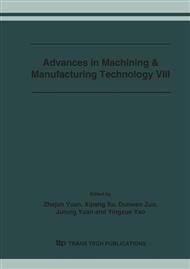p.766
p.770
p.775
p.779
p.784
p.788
p.792
p.796
p.800
Investigation on Adhesion Work and Its Effects on Micro Friction
Abstract:
Since adhesion plays a significant role in microtribology, properties of adhesion work of several materials, such as Si, and mica are investigated by AFM. Experimental results indicate that, measured adhesion work varies with contacting velocity, surface roughness and so on, which is more than a constant. Meanwhile, under invariable loads, friction force of these materials is also measured over a wide range of velocity, which is found that adhesion work of the sample surface directly influences the velocity dependent property of micro friction force. This makes the observed micro frictional behaviour significantly differs from the traditional macro friction laws, in which friction force is proved be independent of sliding velocity. Additionally, with zero or negative load, friction forces are proved to be determined by adhesion work and adhesion contact area. Finally, a relationship between micro friction force and adhesion work is outlined.
Info:
Periodical:
Pages:
784-787
Citation:
Online since:
July 2006
Authors:
Keywords:
Price:
Сopyright:
© 2006 Trans Tech Publications Ltd. All Rights Reserved
Share:
Citation:


